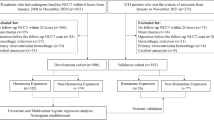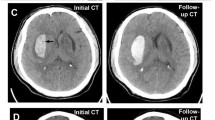Abstract
Objectives
To derivate and validate three scores for the prediction of intracerebral hemorrhage (ICH) expansion depending on the use of non-contrast CT (NCCT), single-phase CTA, or multiphase CTA markers of hematoma expansion, and to evaluate the added value of single-phase and multiphase CTA over NCCT.
Methods
After prospectively deriving NCCT, single-phase CTA, and multiphase CTA hematoma expansion scores in 156 patients with ICH < 6 h, we validated them in 120 different patients. Discrimination and calibration of the three scores was assessed. Primary outcome was substantial hematoma expansion > 6 mL or > 33% at 24 h.
Results
The evaluation of single-phase and multiphase CTA markers gave a steadily increase in discrimination for substantial hematoma expansion over NCCT markers. The C-index (95% confidence interval) in derivation and validation cohorts was 0.69 (0.58–0.80) and 0.59 (0.46–0.72) for NCCT score, significantly lower than 0.75 ([0.64–0.87], p = 0.038) and 0.72 ([0.59–0.84], p = 0.016) for single-phase CTA score, and than 0.79 ([0.68–0.89], p = 0.033) and 0.73 ([0.62–0.85], p = 0.031) for multiphase CTA score, respectively. The three scores showed good calibration in both derivation and validation cohorts: NCCT (χ2 statistic 0.389, p = 0.533; and χ2 statistic 0.352, p = 0.553), single-phase CTA (χ2 statistic 2.052, p = 0.359; and χ2 statistic 2.230, p = 0.328), and multiphase CTA (χ2 statistic 0.559, p = 0.455; and χ2 statistic 0.020, p = 0.887) scores, respectively.
Conclusion
This study shows the added prognostic value of more advanced CT modalities in acute ICH evaluation. NCCT, single-phase CTA, and multiphase CTA scores may help to refine the selection of patients at risk of expansion in different decision-making scenarios.
Key Points
• This study shows the added prognostic value of more advanced CT modalities in acute intracerebral hemorrhage evaluation.
• The evaluation of single-phase and multiphase CTA markers provides a steadily increase in discrimination for intracerebral hemorrhage expansion over non-contrast CT markers.
• Non-contrast CT, single-phase CTA, and multiphase CTA scores may help clinicians and researchers to refine the selection of patients at risk of intracerebral hemorrhage expansion in different decision-making scenarios.


Similar content being viewed by others
Abbreviations
- GCS :
-
Glasgow coma scale
- ICH:
-
Intracerebral hemorrhage
- mRS:
-
Modified Rankin scale
- NCCT:
-
Non-contrast computed tomography
- uHG:
-
Ultraearly hematoma growth
References
Greenberg SM, Ziai WC, Cordonnier C et al (2022) 2022 guideline for the management of patients with spontaneous intracerebral hemorrhage: a guideline from the american heart association/american stroke association. Stroke 53:e282–e361
Demchuk AM, Dowlatshahi D, Rodriguez-Luna D et al (2012) Prediction of haematoma growth and outcome in patients with intracerebral haemorrhage using the ct-angiography spot sign (predict): a prospective observational study. Lancet Neurol 11:307–314
Rodriguez-Luna D, Coscojuela P, Rodriguez-Villatoro N et al (2017) Multiphase ct angiography improves prediction of intracerebral hemorrhage expansion. Radiology 285:932–940
Boulouis G, Morotti A, Charidimou A, Dowlatshahi D, Goldstein JN (2017) Noncontrast computed tomography markers of intracerebral hemorrhage expansion. Stroke 48:1120–1125
Morotti A, Dowlatshahi D, Boulouis G et al (2018) Predicting intracerebral hemorrhage expansion with noncontrast computed tomography: the bat score. Stroke 49:1163–1169
Morotti A, Arba F, Boulouis G, Charidimou A (2020) Noncontrast ct markers of intracerebral hemorrhage expansion and poor outcome: a meta-analysis. Neurology 95:632–643
Arba F, Rinaldi C, Boulouis G, Fainardi E, Charidimou A, Morotti A (2021) Noncontrast computed tomography markers of cerebral hemorrhage expansion: diagnostic accuracy meta-analysis. Int J Stroke 17474930211061639
Yogendrakumar V, Moores M, Sikora L et al (2020) Evaluating hematoma expansion scores in acute spontaneous intracerebral hemorrhage: a systematic scoping review. Stroke 51:1305–1308
Rodriguez-Luna D, Coscojuela P, Rubiera M et al (2016) Ultraearly hematoma growth in active intracerebral hemorrhage. Neurology 87:357–364
Barras CD, Tress BM, Christensen S et al (2009) Density and shape as ct predictors of intracerebral hemorrhage growth. Stroke 40:1325–1331
Selariu E, Zia E, Brizzi M, Abul-Kasim K (2012) Swirl sign in intracerebral haemorrhage: definition, prevalence, reliability and prognostic value. BMC Neurol 12:109
Li Q, Zhang G, Huang YJ et al (2015) Blend sign on computed tomography: novel and reliable predictor for early hematoma growth in patients with intracerebral hemorrhage. Stroke 46:2119–2123
Blacquiere D, Demchuk AM, Al-Hazzaa M et al (2015) Intracerebral hematoma morphologic appearance on noncontrast computed tomography predicts significant hematoma expansion. Stroke 46:3111–3116
Rodriguez-Luna D, Rubiera M, Ribo M et al (2011) Ultraearly hematoma growth predicts poor outcome after acute intracerebral hemorrhage. Neurology 77:1599–1604
Thompson AL, Kosior JC, Gladstone DJ et al (2009) Defining the ct angiography “spot sign” in primary intracerebral hemorrhage. Can J Neurol Sci 36:456–461
Brott T, Broderick J, Kothari R et al (1997) Early hemorrhage growth in patients with intracerebral hemorrhage. Stroke 28:1–5
Wada R, Aviv RI, Fox AJ et al (2007) Ct angiography “spot sign” predicts hematoma expansion in acute intracerebral hemorrhage. Stroke 38:1257–1262
Rodriguez-Luna D, Boyko M, Subramaniam S et al (2016) Magnitude of hematoma volume measurement error in intracerebral hemorrhage. Stroke 47:1124–1126
Sullivan LM, Massaro JM, D’Agostino RB Sr (2004) Presentation of multivariate data for clinical use: the framingham study risk score functions. Stat Med 23:1631–1660
Goldstein JN, Fazen LE, Snider R et al (2007) Contrast extravasation on ct angiography predicts hematoma expansion in intracerebral hemorrhage. Neurology 68:889–894
Rodriguez-Luna D, Dowlatshahi D, Aviv RI et al (2014) Venous phase of computed tomography angiography increases spot sign detection, but intracerebral hemorrhage expansion is greater in spot signs detected in arterial phase. Stroke 45:734–739
Zheng J, Yu Z, Xu Z et al (2017) The accuracy of the spot sign and the blend sign for predicting hematoma expansion in patients with spontaneous intracerebral hemorrhage. Med Sci Monit 23:2250–2257
Morotti A, Boulouis G, Charidimou A et al (2018) Integration of computed tomographic angiography spot sign and noncontrast computed tomographic hypodensities to predict hematoma expansion. Stroke 49:2067–2073
Li Q, Zhang G, Xiong X et al (2016) Black hole sign: novel imaging marker that predicts hematoma growth in patients with intracerebral hemorrhage. Stroke 47:1777–1781
Boulouis G, Morotti A, Brouwers HB et al (2016) Association between hypodensities detected by computed tomography and hematoma expansion in patients with intracerebral hemorrhage. JAMA Neurol 73:961–968
Li Q, Liu QJ, Yang WS et al (2017) Island sign: an imaging predictor for early hematoma expansion and poor outcome in patients with intracerebral hemorrhage. Stroke 48:3019–3025
Yu Z, Zheng J, Ali H et al (2017) Significance of satellite sign and spot sign in predicting hematoma expansion in spontaneous intracerebral hemorrhage. Clin Neurol Neurosurg 162:67–71
Funding
The authors state that this work has not received any funding.
Author information
Authors and Affiliations
Corresponding author
Ethics declarations
Guarantor
The scientific guarantor of this publication is David Rodriguez-Luna.
Conflict of interest
The authors of this manuscript declare no relationships with any companies, whose products or services may be related to the subject matter of the article.
Statistics and biometry
David Rodriguez-Luna has significant statistical expertise.
Informed consent
Written informed consent was obtained from all subjects (patients) or their relatives in this study.
Ethical approval
Institutional Review Board approval was obtained.
Study subjects or cohorts overlap
Some study subjects have been previously reported in Rodriguez-Luna D, Coscojuela P, Rodriguez-Villatoro N, et al (2017) Multiphase CT Angiography Improves Prediction of Intracerebral Hemorrhage Expansion. Radiology 285:932–940.
Methodology
• prospective
• observational
• performed at one institution
Additional information
Publisher's note
Springer Nature remains neutral with regard to jurisdictional claims in published maps and institutional affiliations.
Supplementary Information
Below is the link to the electronic supplementary material.
Rights and permissions
Springer Nature or its licensor (e.g. a society or other partner) holds exclusive rights to this article under a publishing agreement with the author(s) or other rightsholder(s); author self-archiving of the accepted manuscript version of this article is solely governed by the terms of such publishing agreement and applicable law.
About this article
Cite this article
Rodriguez-Luna, D., Pancorbo, O., Coscojuela, P. et al. Derivation and validation of three intracerebral hemorrhage expansion scores using different CT modalities. Eur Radiol 33, 6045–6053 (2023). https://doi.org/10.1007/s00330-023-09621-0
Received:
Revised:
Accepted:
Published:
Issue Date:
DOI: https://doi.org/10.1007/s00330-023-09621-0




